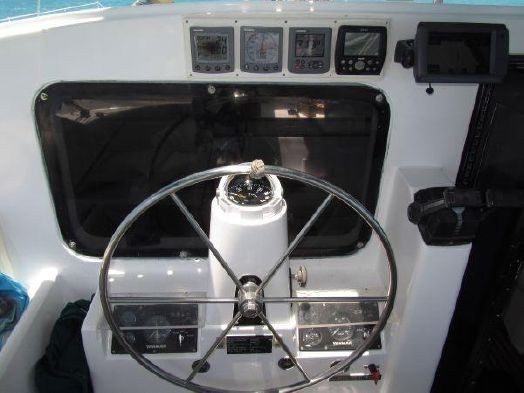While Away - Electronics
11 June 2020
by Alan Duffy

When on the boat during the last visit I looked for items that needed upgrading or replacement. Many of these items are simply purchase and then install when back at the boat, while others are items can be made while away from the boat.
Several of the boats electronic items had been looted (VHF, Chart Plotter), others damaged during the hurricane (Wind Instruments), and others by age/corrosion (secondary GPS, Log display). The majority of what remained was old, outdated and required replacement.
Looking at the instrument options on the market I decided to use the industry standard NMEA2000 interface. While Raymarine's version/implementation (Seatalk NG) is similar, I prefer to stick with an open standard.
The current implementation on the boat was Raymarine's implementation of NMEA0183 (Seatalk), the only thing that remained was the depth gauge. It made sense to discard the aged depth sounder and display and replace with all new NMEA2000 style solution.
While standards are meant to produce a method for different manufacturers to interface and exchange information, it also results in some functionality restrictions. Unfortunately standardization requires conformance to the lowest common denominator. It is for this reason my goal is to select a "solution" rather than item#1 form vendor X, item#2 from vendor Y, item#3 from vendor Z, etc. There will be exceptions to this approach, however it is a goal rather than a hard set rule.
When looking at the different options available, it was a shock at the price of a complete system. The systems offered nice solutions, but they were well beyond my intended use. I decided to select a product vendor and use the individual items that were needed which provided the features I desired. The two vendors which had products that I liked were B&G and Garmin.
Scanning the internet for pricing on the products, the Garmin products would be on sale "somewhere" so it was possible to buy the pieces I needed immediately at a reasonable price.....(since when is boat products reasonably priced). Add to the system when required and budget permitted. I also wanted to learn how to better use the product, so being able to try it at home and familiarize myself with the equipment seemed also a good approach.
Instruments which were needed in the short term at the boat included the thru hull for the log/depth/temp sensor (needed as the current one was removed to fix keel), and wind instruments (needed to be included in the mast repair). As it happened I found a combination that had both items and had it shipped to Mark for use directly on the boat.
Items which I wanted to familiarize myself with at home included the chart plotter and DSC VHF radio. I ordered these from different outlets when they were on sale, saving a significant amount. Also ordered the different pieces to build the NMEA2000 backbone and a 12Vdc supply to power them up at home. This learning approach at home will certainly help time when installing at the boat.
Still waiting for the Garmin AIS transponder to be on sale :)
The intention is to use a separate VHF antenna mounted on the arch for the AIS system. An external antenna splitter will reduce the power and efficiency for both devices operating through the splitter. Having the 25W VHF available at sea via the mast mounted antenna is a bonus. Should the mast come down, then there is still and antenna available for that same 25W radio as opposed to relying on the limited range of a 5W hand held in such an emergency.
Another area that was damaged during the hurricane was the solar panel installation. The panels were located on the bimini and had been left there during the storage on the hard. The panels and wiring was destroyed. The controller is still there but its condition is unknown. The davit arch, which appears to either been used in the past or was design for future use to support solar panels. I intend to install the panels on the arch, this wont be done till much later in the project, but preparing for the install will save time.
Have also been putting together items to do the physical wiring of these new products (tinned wire, marine heat shrink, terminal connectors, crimping tool, circuit breakers, VHF antennas, coax, etc).



Comments